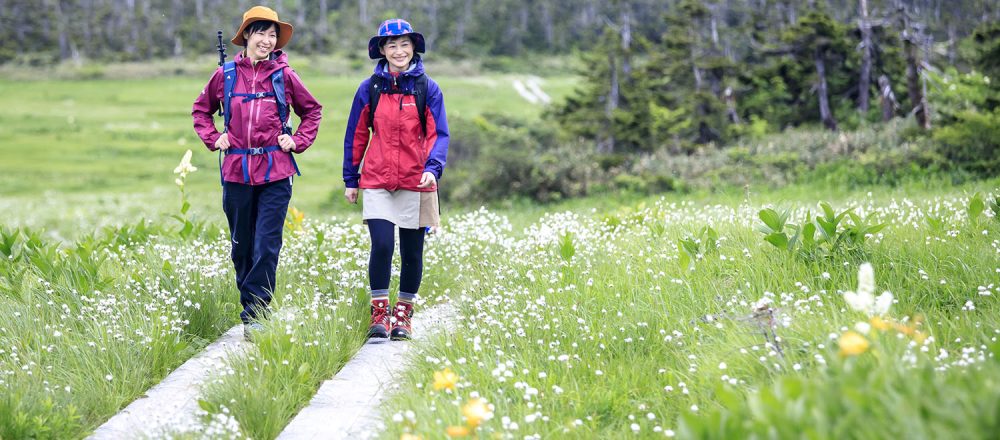
In Japanese, the “tai” in Hachimantai refers to flatness. This is appropriate, because Mt. Hachimantai’s summit is remarkably flat, more akin to a plateau in terrain rather than a mountain. This makes it easy to traverse for children and elderly, and removes any need for heavy gear; anyone can trek it with minimal prep!
Both Mt. Hachimantai and Mt. Iwate are counted among Japan’s 100 most famous mountains. A long ridge runs all the way from Mt. Maemori in Appi Kogen, through Mt. Hachimantai and up to Mt. Iwate. The trail that runs along this ridge connects to the Yakehashiri trailhead, and is consequently known as the “Iwate-Hachimantai-Appi Kogen 50km Trail.” For serious trekkers, it’s the one of the most prominent trails in the country. Among those aiming to challenge this horseshoe-shaped trail, there are many who stop in at Appi Kogen and the Onsenkyō area to sample the many hot springs between hikes. It’s a trekking paradise that offers courses for people of all experience and fitness levels. The great expanse of Japan’s national park is waiting!

Even on Mt. Hachimantai, which is quite accessible to newcomers, these items are the bare minimum that all visitors should bring.
【Belongings】
Etc.
Additionally, if necessary:
Etc.
【Anti-Infection Items】
Prefectural Border Trailhead→15min, approx.0.5㎞→Mt. Hachimantai Summit→10min, approx.0.4㎞→Hachiman-numa – Gama-numa Observatory→10min, approx.0.4㎞→Mikaeri Ridg→10min, approx.0.5㎞→Prefectural Border Trailhead
Travel Time 55min, approx. 2.4km total
Prefectural Border Trailhead→15min, approx.0.5㎞→Mt. Hachimantai Summit→10min, approx.0.4㎞→Hachiman-numa – Gama-numa Observatory→10min, approx.0.4㎞→Ryounso→5min, approx.0.3㎞→Genta-Wakare→10min, approx.0.5㎞→Gentamori→10min, approx.0.5㎞→Genta-Wakare→25min, approx.1.1㎞→Mikaeri Ridge→10min, approx.0.5㎞→Prefectural Border Trailhead
Travel Time 1hr 50min, approx. 4.9km
Kuroyachi-Iriguchi→15min, approx.0.5㎞→Kuroyachi Wetlands→40min, approx.1.5㎞→Gentamori→10min, approx.0.5㎞→Genta-Wakare→15min, approx.0.5㎞→Ryounso→5min, approx.0.3㎞→Hachiman-numa – Gama-numa Observatory→10min, approx.0.4㎞→Mt. Hachimantai Summit→25min, approx.1.1㎞→Prefectural Border Trailhead
Travel Time 1hr 45min, approx. 4.3km
Chausu-Guchi→40min, approx.1.2㎞→Chausu-Sanso→5min, approx.0.2㎞→Mt. Chausu Observatory→5min, approx.0.2㎞→Chausu-Sanso→25min, approx.1.3㎞→Kuroyachi Wetlands→40min, approx.1.5㎞→Gentamori→10min, approx.0.5㎞→Genta-Wakare→15min, approx.0.5㎞→Ryounso→5min, approx.0.3㎞→Hachiman-numa – Gama-numa Observatory→10min, approx.0.4㎞→Mt. Hachimantai Summit→25min, approx.1.1㎞→Prefectural Border Trailhead
Travel Time 3hrs, approx. 7.2km
Prefectural Border Trailhead→15min, approx.0.5㎞→Mt. Hachimantai Summit→10min, approx.0.4㎞→Hachiman-numa – Gama-numa Observatory→10min, approx.0.4㎞→Mikaeri Ridg→10min, approx.0.5㎞→Prefectural Border Trailhead
Travel Time 55min, approx. 2.4km total
Prefectural Border Trailhead→15min, approx.0.5㎞→Mt. Hachimantai Summit→10min, approx.0.4㎞→Hachiman-numa – Gama-numa Observatory→10min, approx.0.4㎞→Ryounso→5min, approx.0.3㎞→Genta-Wakare→10min, approx.0.5㎞→Gentamori→10min, approx.0.5㎞→Genta-Wakare→25min, approx.1.1㎞→Mikaeri Ridge→10min, approx.0.5㎞→Prefectural Border Trailhead
Travel Time 1hr 50min, approx. 4.9km
Kuroyachi-Iriguchi→15min, approx.0.5㎞→Kuroyachi Wetlands→40min, approx.1.5㎞→Gentamori→10min, approx.0.5㎞→Genta-Wakare→15min, approx.0.5㎞→Ryounso→5min, approx.0.3㎞→Hachiman-numa – Gama-numa Observatory→10min, approx.0.4㎞→Mt. Hachimantai Summit→25min, approx.1.1㎞→Prefectural Border Trailhead
Travel Time 1hr 45min, approx. 4.3km
Chausu-Guchi→40min, approx.1.2㎞→Chausu-Sanso→5min, approx.0.2㎞→Mt. Chausu Observatory→5min, approx.0.2㎞→Chausu-Sanso→25min, approx.1.3㎞→Kuroyachi Wetlands→40min, approx.1.5㎞→Gentamori→10min, approx.0.5㎞→Genta-Wakare→15min, approx.0.5㎞→Ryounso→5min, approx.0.3㎞→Hachiman-numa – Gama-numa Observatory→10min, approx.0.4㎞→Mt. Hachimantai Summit→25min, approx.1.1㎞→Prefectural Border Trailhead
Travel Time 3hrs, approx. 7.2km
Aka-numa Fudo Entrance →25min, approx.0.8㎞→ Gazebo →20min, approx.0.7㎞→ Promenade entrance →20min, approx.0.7㎞→ Gazebo →25min, approx.0.8㎞→ Aka-numa Fudo Entrance
Travel Time 1hr 30min, approx. 3km
Travel Time 40min, approx. 4km
Nanataki Trailhead →40min, approx.2.2㎞→ Nanataki →30min, approx.2.2㎞→ Nanataki Trailhead
Travel Time 1hr 10min, approx. 4.4km
Mt. Gentagatake Trailhead →50min, approx. 1.9㎞→ Marumorigawa Deai →75min, approx. 1.6㎞→ Junction →30min, approx. 0.8㎞→ Mt. Gentagatake →15min, approx. 0.7㎞→ Traverse Route Junction →20min, approx. 0.8㎞→ 大Obuka-Sanso →45min, approx. 2.2㎞→ Junction →50min, approx. 1.6㎞→ Marumorigawa Deai →40min, approx. 1.9㎞→ Mt. Gentagatake Trailhead
Travel Time 5hrs 25min, approx. 11.5km
Nanataki Trailhead →40min, approx.2.2㎞→ Nanataki →30min, approx.2.2㎞→ Nanataki Trailhead
Travel Time 1hr 10min, approx. 4.4km